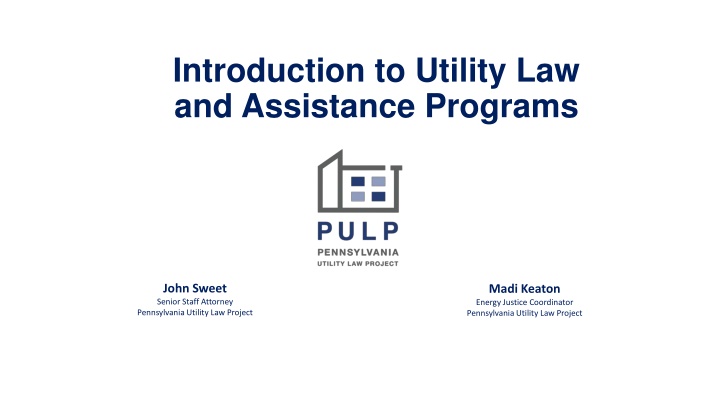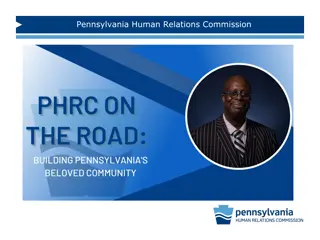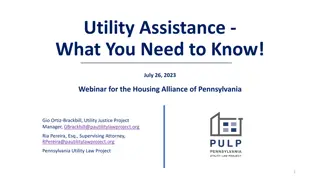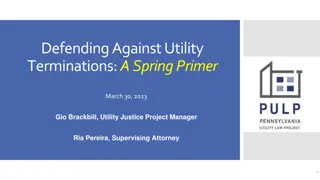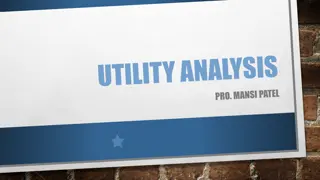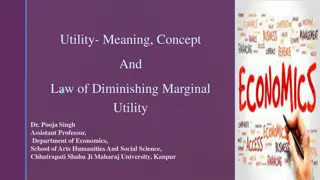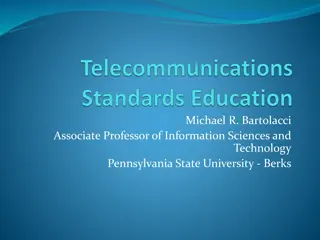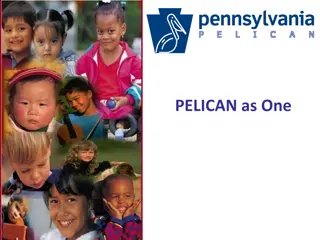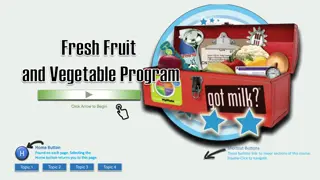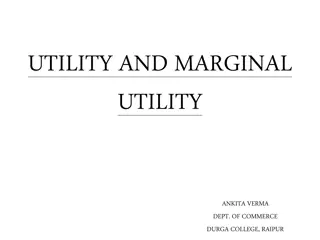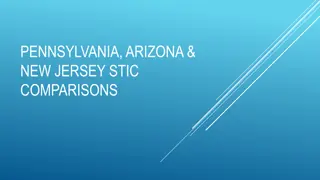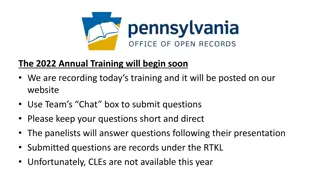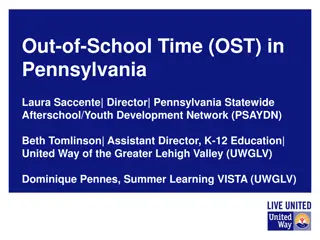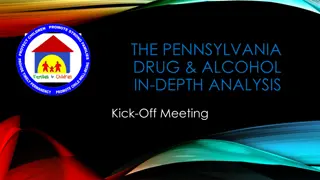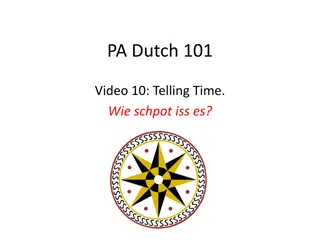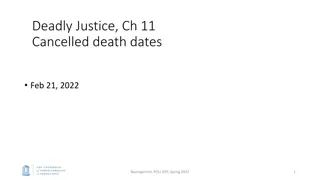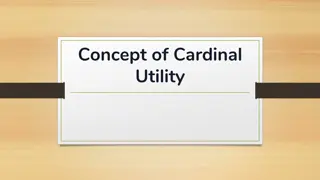Utility Law and Assistance Programs in Pennsylvania
Learn about the Pennsylvania Utility Law Project (PULP) and its mission to ensure access to safe and affordable utility services for low-income Pennsylvanians. Explore systematic inequities, barriers, and utility unaffordability faced by marginalized communities. Discover insights on federal poverty levels and the impact on utility affordability.
Download Presentation

Please find below an Image/Link to download the presentation.
The content on the website is provided AS IS for your information and personal use only. It may not be sold, licensed, or shared on other websites without obtaining consent from the author.If you encounter any issues during the download, it is possible that the publisher has removed the file from their server.
You are allowed to download the files provided on this website for personal or commercial use, subject to the condition that they are used lawfully. All files are the property of their respective owners.
The content on the website is provided AS IS for your information and personal use only. It may not be sold, licensed, or shared on other websites without obtaining consent from the author.
E N D
Presentation Transcript
Introduction to Utility Law and Assistance Programs John Sweet Senior Staff Attorney Pennsylvania Utility Law Project Madi Keaton Energy Justice Coordinator Pennsylvania Utility Law Project
Pennsylvania Utility Law Project PULP is a statewide specialty legal services program within the Pennsylvania Legal Aid Network. PULP s mission is to ensure that all low income Pennsylvanians can access and maintain safe and affordable utility service. Legal Representation Education Supportive Services Consultation
Systematic Inequities and Barriers to Utility Service John Sweet Senior Staff Attorney Pennsylvania Utility Law Project
Systematic Inequities and Barriers to Utility Service Low income, Black, and Latino/a/x residents are more likely to be rent-burdened and pay more money toward their utility and experience utility insecurity. Communities of color have much higher rates of utility debt and disconnections as well as much higher rates of enrollment in utility assistance programs, especially during the COVID-19 pandemic.1 Survey data from Indiana University shows correlation beyond poverty status: Compared to low income white households, low income Black households are sent utility disconnection notices twice as often and have their electricity disconnected at five times as often. Latino/a/x households receive notices at five times the rate and lost electricity at eight times as often.2
Federal Poverty Level 2021 Federal Poverty Limit Guidelines Household Members 150% FPL 250% FPL 300% FPL 1 2 3 4 5 $19,320 $26,130 $32,940 $39,750 $46,560 $32,200 $43,550 $54,900 $66,250 $77,600 $38,640 $52,260 $65,880 $79,500 $93,120 Full Time Minimum Wage ($7.25/hr): $15,080/year
Utility Unaffordability Pre-COVID-19 Low income households pay as much as 30% of income on home energy costs. Black and Latino/a/x families have disproportionately high energy burdens Water / wastewater also regularly exceeds 10% of income for low income households.
Utility Unaffordability During COVID-19 Low-income households disproportionately so in Black and Latino/a/x communities experienced greatest job loss, food and medicine insecurity, and accrual of debt. Utility usage has increased as families spent (and continue to spend) more time at home using more water, electricity, heating services, and internet than ever. These same households are also at a higher risk of exposure to COVID-19 and have experienced greater hospitalization rates and death. Low and fixed income households have struggled to access stimulus payments and other federal stimulus benefits.
Other Critical Factors Driving Utility Affordability Crisis Water and Wastewater Privatization and Consolidation Critical Infrastructure Needs Clean Energy Transition Residential Energy Competition
Utility Insecurity Causes Lasting Harm Long-term impact on consumer credit Liens (municipal utilities) encumber property Destabilizes housing Catalyst for eviction, foreclosure, and homelessness Results in condemnation Difficulty relocating Ineligibility for public and private housing Worsens health conditions Exposure to extreme heat and cold Inability to properly sanitize Lack of clean drinking water Interrupts family unity (CYS/custody disputes) Hinders child learning and development Severs critical communication with work/school Utility moratoria nationwide reduced COVID-19 infection rates by 4.4% and reduced mortality rates by 7.4%. Source: Duke University, NBER, Working Paper
The housing crisis and economic recession of 2008 provides a cautionary tale. In 2008, more than 1 in 5 low income Pennsylvanians had their electric service terminated for nonpayment, and 1 in 6 experienced a natural gas termination. In 2014, following the Polar Vortex, low income Pennsylvanians again faced a spike in terminations, this time driven by instability in competitive market pricing. Electric Termination Rates (2001-2019) 25.00% Termination Rate 20.00% 15.00% 10.00% 5.00% 0.00% 2001* 2002 2003 2004 2005 2006 2007 2008 2009 2010 2011 2012 2013 2014 2015** 2016** 2017 2018 2019 Residential Termination Rate Low Income Termination Rate Gas Termination Rates (2002-2019) 20.00% Termination Rate 15.00% 10.00% 5.00% 0.00% 2002 2003 2004 2005 2006 2007 2008 2009 2010 2011 2012 2013 2014 2015** 2016** 2017 2018** 2019**
Looming Crisis $852 million in residential debt, up 44% year over year. 814,000 at risk residential accounts. February 2021 October 2021 280,000 Terminations Heating costs are projected to increase 15-54%, depending on fuel source. Winter 2021/2022 Major utilities approved to increase distribution rates approximately $500,000,000 annually. March 2020 to Today 2022/2023 .
Utility Law and Consumer Protections John Sweet Senior Staff Attorney Pennsylvania Utility Law Project
Utility Basics What are Utilities? Regulated Large electric, natural gas, and water companies. Includes: Electric: PECO, PPL, First Energy (Met Ed, Penelec, Penn Power, West Penn Power), Duquesne Light Natural Gas: UGI, PGW, Columbia, Peoples, NFG Water: Pa. American Water, Suez, Aqua, and most recently the Pittsburgh Water and Sewer Authority Unregulated Municipal utilities (with the exception of PGW and PWSA) and Electric Co-Ops
Protections from Termination Winter Moratorium Medical Certificates Special Protections for Domestic Violence Survivors Payment Arrangements Utility Issued PUC Issued
Tenant Statistics and Vulnerability Minority households are significantly more likely to be renters. One quarter of tenants pay at least 50% of their income toward housing costs. Approximately 1/3 of renters have children in the household. Tenants are often not the named utility customer because the account is in the landlord s name especially for water and wastewater.
Utility Rights & Obligations: Tenants Right to continued service where termination is due to nonpayment by landlord ratepayer Landlord cannot purposefully disconnect service to a tenant occupied property Entitled to 30 days notice before termination Landlord retaliation prohibited Regulated Utilities only: Tenant can t be charged service provided to common area or another unit
Emergency COVID Utility Relief Madi Keaton Energy Justice Coordinator Pennsylvania Utility Law Project
Low Income Household Water Assistance Program - LIHWAP Eligibility 150% FPL Water / wastewater responsibility At risk of termination / service off Utility agrees to maintain service for minimum 90 days after grant received Benefits Up to $2,500 Program Opened JANUARY 4, 2022.
Emergency Rental [and Utility] Assistance Program (ERAP) Eligibility 80% Area Median Income Reduced income, substantial costs, or other COVID-related financial hardship **Soon to be expanded to anyone with financial hardship DURING pandemic not just related to! Risk of housing instability / homelessness Benefits Up to 12 mo. rent, utility, and home energy costs and arrears, plus up to 3 additional months. **Soon to be expanded to 18 months Other housing related expenses incurred directly or indirectly due to COVID-19 Housing stability services Applications available through Compass
Emergency Rental [and Utility] Assistance Full Arrears vs. Amount Due Extended payment arrangements, while helpful as an interim relief measure to prevent termination, have caused some households to receive a lesser grant through ERAP. ERAP should pay all rent and utility debt (within 12 / 18 mo limit), not just the current amount due. Lack of Clear Appeals Process All counties should have an established dispute process and are required to provide applicants with information about how to appeal an adverse decision or inaction.
Homeowners Assistance Fund (HAF) Administered by the Pennsylvania Housing Finance Agency (PHFA) Proposed State Plan Includes utility relief for energy and water / wastewater debts. Requirement to apply for other utility relief first. Process unclear at this time. Program anticipated to open sometime in Spring 2022
Emergency Broadband Benefit (EBB) https://www.fcc.gov/broadbandbenefit Benefit: Up to $50 / month broadband subsidy $100 device discount, with $10-$50 co-payment Eligibility: Qualify for Lifeline, free/reduced school lunch, Pell Grant recipient, substantial loss in income since March 2020 and income under $99K for single or $198K for joint filers, OR eligible for provider s existing low income or COVID-19 program
Federal Programs Madi Keaton Energy Justice Coordinator Pennsylvania Utility Law Project
Lifeline https://www.usac.org/lifeline/ Benefits: Monthly subsidy for telephone, broadband, or bundled service Eligibility: Income at or below 135% FPL, or categorical eligibility SNAP, Medicaid, SSI, Public Housing, or Veteran Pension/Survivor Benefits
Low Income Home Energy Assistance Program (LIHEAP) LIHEAP Season: October 18, 2021 May 6, 2022 Cash Grant - $500 - $1,500 Crisis Grant - $25 - $1,200 Crisis Interface Emergency Furnace Repair
Low Income Home Energy Assistance Program (LIHEAP) Eligibility Household income at/below 150% FPL Home heating responsibility PA residency Additional Eligibility for Crisis Grants Actual or imminent home heating emergency Grant will resolve the crisis How to Apply: Apply in person at local County Assistance Office Apply online at Pa. COMPASS (https://www.compass.state.pa.us/) Call LIHEAP Hotline (1-866-857-7095) to request application
Weatherization Assistance Program (WAP) Weatherization saves families an average of $283 each year and can reduce heating bills up to 30%. Funded by Dep t of Energy (DOE), administered by Dep t of Community and Economic Development Eligibility: 200% FPL Pennsylvania resident Landlord permission (if renter) Benefits: Diagnostic assessment of air leakage Health and safety repairs Electric baseload measures (energy efficiency and reduction) Client energy education Health and Safety Deferrals
Clean & Tune Program (Pilot) DCED launched a new pilot program to provide furnace maintenance service to households that received LIHEAP crisis interface (emergency furnace repair) last year or this year. Possible services include: Furnace cleaning, testing, replacement parts / filters Health / safety inspections Education and instruction Installation of basic efficiency and weatherization measures, as well as programmable thermostat Contact your local Weatherization Assistance Program provideror local County Assistance Office for more information or to apply.
Utility-Specific Programs Madi Keaton Energy Justice Coordinator Pennsylvania Utility Law Project
Customer Assistance Programs (CAP) Available to customers of regulated gas and electric companies. Some regulated water companies offer limited assistance programs as well. Benefits: Reduced rates / lower monthly payments Past debt frozen Debt forgiveness earned over time Eligibility Requirements: At or below 150% FPIG Payment troubled Periodic income verification
Hardship Fund Programs Benefits Cash grant, typically up to $500 to resolve crisis Eligibility and program terms vary by utility Typical terms include: 200% FPL or below Recent payments / attempts to make payments Temporary hardship Some utilities prohibit current CAP customers from also receiving hardship fund grant assistance, but some will make exceptions.
Low Income Usage Reduction Program (LIURP) Benefits: Free home energy audit to identify cost-effective ways to reduce energy usage. Free energy efficiency and usage reduction measures. May include: Some utilities also offer emergency furnace repair / replacement services through LIURP General Eligibility: Income at/below 200% FPL High usage Landlord permission (if renter) * Note: Electric utilities also offer Act 129 energy reduction services to households who do not meet LIURP minimum usage requirements or who are over income.
Resources Additional resources available on PULP s website at: https://www.rhls.org/utilities/pulp/links-to-utility-resources Office of Consumer Advocate (OCA) If consumer is over income for legal services, the OCA may be able to help. www.oca.state.pa.us 800-684-6560 / consumer@paoca.org Pa. PUC Bureau of Consumer Services Informal Complaints: 800-692-7380 Informal, pro-se friendly process Filing an informal complaint before the date of termination will temporarily stop the termination until an investigation is complete. Formal Complaints: www.puc.state.pa.us/filing_resources/filing_complaints.aspx
Contact Information Training and Technical Assistance: pulp@pautilitylawproject.org Emergency Utility Hotline (Statewide): 844-645-2500 Madi Keaton, Energy Justice Coordinator mkeaton@pautilitylawproject.org John Sweet, Senior Staff Attorney jsweet@pautilitylawproject.org
